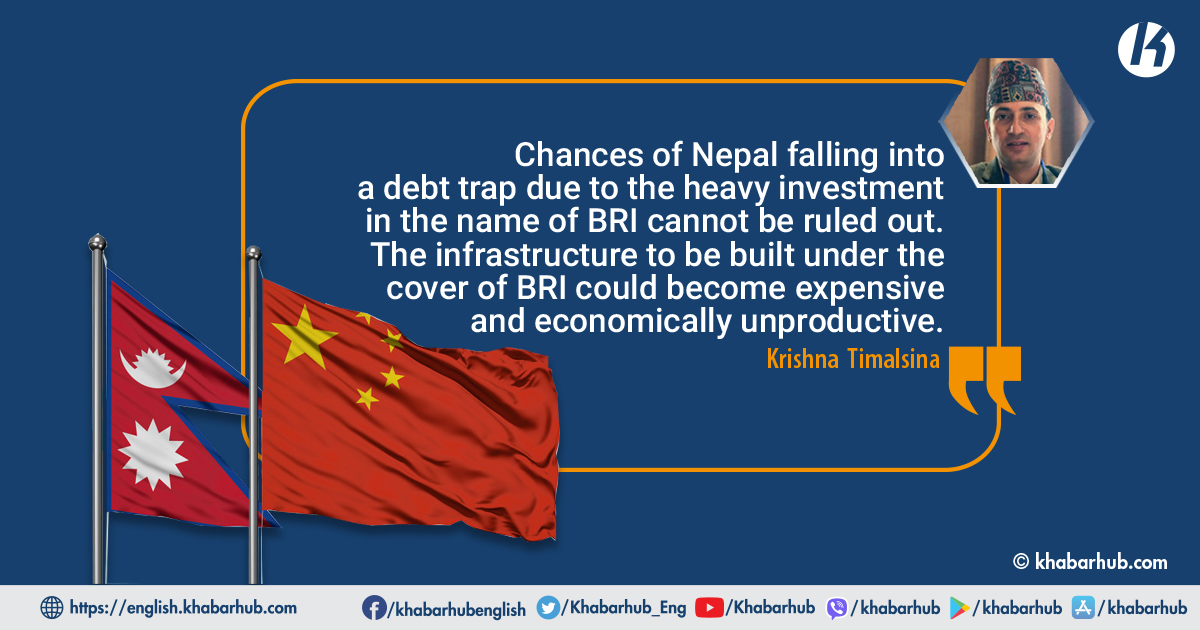KATHMANDU: It has been five years since Nepal and China signed the Belt and Road Initiative (BRI).
The then Deputy Prime Minister Krishna Bahadur Mahara, who visited Beijing on May 12, 2017, to sign the BRI, was unfortunately unaware of the terms and conditions of the agreement.
Since then, the agreement has been the subject of much debate and skepticism, but five years later, the two countries have kept a shadow copy of the agreement.
Amidst confusion and apprehension, the then Prime Minister KP Oli visited China in June 2018.
In a joint statement issued during the visit, it was stated that Nepal is committed to the implementation of BRI.
But the leaders advocating for the BRI are unable to give a concrete answer as to what strategy the project is pursuing.
In a joint statement issued from Beijing, the two sides agreed to expedite the implementation of the Memorandum of Understanding (MoU) on cooperation under the BRI to enhance connectivity within the overall framework of cross-border Himalayan multidimensional connectivity.
However, Dr. Jagdish Chandra Pokhrel, a planner, says that the issue of China’s railways and oil is under constant doubt as it is not yet clear which model China will invest in the mentioned projects and infrastructure and what will be Nepal’s ownership and contribution in those infrastructures.
In the midst of this confusion and apprehension, President Bidyadevi Bhandari paid a state visit to China in April 2019.
During the visit, the two countries again signed an agreement to promote a cross-border multidimensional network under the BRI project.
A joint statement issued before President Bhandari’s return to Nepal also stated that a cross-border rail network would be set up to promote a cross-border multi-dimensional infrastructure network between the two countries under the BRI project.
If China’s conditions and proposals and Nepal’s needs are not put into public debate by putting forward the blueprint of the BRI project, then Nepal may also fall into a debt trap in the name of development and infrastructure.
However, the government of Nepal has not made public the details of Beijing’s interest in investing in building a multidimensional cross-border infrastructure network to expand the railway project.
Former Ambassador Hiranya Lal Shrestha said that the investment model, loan and grant or conditions for the construction of infrastructure have been included in the detailed agreement but the details of the agreement have not been made public by both the countries.
Shrestha, who has written dozens of books on Nepal-China relations, also complained that the original document of the BRI agreement was not provided by any side.
In the five years since the signing of the BRI, Chinese Foreign Minister Wang Yi has visited Nepal five times.
Dozens of high-ranking Chinese officials, including Chinese President Xi Jinping, visited Nepal.
There have been dozens of high-level visits from Nepal to China. The issue of BRI is never left out in every visit from both sides.
However, the Belt and Road Initiative (BRI) and five other separate agreements have not been made public.
Even experts/stakeholders who previously opposed the US grant project, the Millennium Challenge Corporation (MCC), are least bothered about raising the challenges of BRI.
Unsurprising debate about BRI
BRI, as claimed by China, is a development project. However, China has a hidden interest to become a world power.
Under this strategy, China has invested heavily in African countries with low purchasing power and abundant natural minerals and resources.
The infrastructure built on loans that the national economy cannot afford is part of China’s BRI project.
Vijay Kant Karna, a professor at Tribhuvan University, says China has invested heavily in African countries for two decades.
China is now seeking to connect politically and diplomatically with democratic countries through the BRI project, according to Karna.
Meanwhile, according to Shrestha, Nepal has already signed five agreements with China over a period of five years.
But the terms of the agreement have never been debated in Nepal because of which Nepal may be burdened with huge debt if the BRI projects are implemented.
Nepal can also head in the direction of Sri Lanka, Maldives, or Pakistan if it accepts non-transparent agreements and conditions.
Foreign Affairs expert Arun Kumar Subedi warns heavy investment in Nepal could lead the country toward China’s debt trap.
The investment in Pokhara Airport is one such example. The Chinese investment of more than Rs 65 billion in feasibility study of railways, expansion of transmission lines and construction of a model industrial park in Damak, Jhapa are similar unclear loan investments.
Subedi fears that the infrastructure to be built under the cover of BRI could become as expensive and economically unproductive as the Pokhara airport.
According to Subedi, Nepal was not included in the initial map of BRI.
He makes it a point to say that China’s interests and one-sided agenda could prevail in the BRI agreement.
If China’s conditions and proposals and Nepal’s needs are not put into public debate by putting forward the blueprint of the BRI project, then Nepal may also fall into a debt trap in the name of development and infrastructure.
Therefore, there has been no independent analysis of BRI projects and investments in Nepal, including profit and loss.
The preamble to the BRI agreement states that with the expansion of roads, electricity, technology and rail network, markets and connectivity with the outside world will be expanded and Nepal will benefit from this, but how will Nepal benefit?
Diplomat Hiranya Lal Shrestha said that there was no debate in favor of Nepal.
What good is a website if it simply “blends in” with everything else out there?
According to diplomat Shrestha, Nepal should be able to ask questions.
“Nepal cannot afford to borrow in the name of implementing a strategic plan to find a Chinese market. We have to claim full subsidy,” Shrestha said.
Confusion everywhere, interest everywhere
Currently, an agreement has been reached between the two countries on the feasibility study of the Kerung-Kathmandu railway line under BRI.
A statement issued by the Ministry of Foreign Affairs after Chinese Foreign Minister Wang’s last visit to Nepal a month ago mentioned the feasibility study of the Kerung-Kathmandu railway line, but the two countries did not say whether it was part of the BRI project.
The two countries have not disclosed whether they will invest in the construction of the railway, which is said to connect China and India, the two largest markets in the world, or whether they will accept China’s expensive loan.
According to experts, China is carrying out most of the projects under BRI through China Development Bank, Export-Import Bank, Silk Road Fund, and Asian Infrastructure Development Bank.
The Chinese government has asked the bank to sign an agreement stating that the investment and terms of the Chinese fund should be kept confidential.
Interest rates and terms are never made public due to bank and financial secrecy.
According to the World Bank, more than 40 countries around the world are currently trapped in Chinese debt. The share of debt that is not visible in the statistics is even worse.
Under this strategy, more than five dozen Chinese companies are now investing in around 2,000 BRI projects in different countries of the world.
The investment interest rate is more expensive than the interest paid by the Chinese government.
The investment in Pokhara Airport is one such example. The Chinese investment of more than Rs 65 billion in feasibility study of railways, expansion of transmission lines and construction of a model industrial park in Damak, Jhapa are similar unclear loan investments.
As it is not clear which model of investment Nepal has been sought and on what terms it has signed, the model of investment made by China in Nepal is unclear.
The issue of such serious economic and strategic concern has not even become the subject of parliamentary debate to date.
After Nepal signed the BRI project, it initially sent a list of 35 and then 22 projects.
China’s consistent focus
After Nepal signed the BRI agreement, Chinese President Xi Jinping paid a state visit to Nepal in October 2019.
During the visit, China urgently raised the issue of the implementation of the BRI agreement.
However, even Xi, who declared Nepal a land-linked country from a landlocked country, did not reveal anything about the Chinese investment model.
In a joint statement issued by the two countries, it was mentioned that a feasibility study of the Kathmandu-Kerung railway has been agreed upon.
However, the Chinese side has not yet clarified the modalities of the project. The need for railways, Nepal’s investment potential and priorities were not discussed.
Economist Dr. Bimal Koirala also says that Nepal should put pressure on China to build large projects with grants.
This is because Nepal’s prosperity, development and sustainability have implications for China’s sustainability, and the Chinese investment model has an impact on the form of investment coming in from India and the Third World.
China does not disclose details of investments and loans made in such projects, and lending banks are required to keep the terms of such agreements confidential.
Otherwise, if the BRI project is accepted blindly as a weapon to reduce its dependence on India, it could become a debt trap.
China’s heavy investment
According to the World Bank, more than 40 countries around the world are currently trapped in Chinese debt. The share of debt that is not visible in the statistics is even worse.
China, which is constantly trying to interfere in the World Bank’s investment sector by disbursing non-transparent loans, has put forward the China Development Bank, Export-Import Bank, Silk Road Fund and Asian Infrastructure Development Bank in most of the projects in the world.
China has similar investments in countries including China-Pakistan Economic Corridor, Maldives, Djibouti, Laos, Zambia and Kazakhstan.
As a result, these countries are overwhelmed by Chinese debt, which accounts for more than 20 percent of annual GDP.
Strategic roads, railways, airports, ports, and mining and energy projects are coming under the control of the Chinese company.
China does not disclose details of investments and loans made in such projects, and lending banks are required to keep the terms of such agreements confidential.
The British intelligence agency MI6 has concluded that due to such conditions, the borrowing countries could not disclose the details of the loan with China.
Richard More, a longtime head of the agency, told the BBC that China had made it a clear condition that such secrecy is maintained when signing an international loan agreement.
Because China has kept secret its international trade debt, it is unclear how much it is investing and how much money it has.








Comment